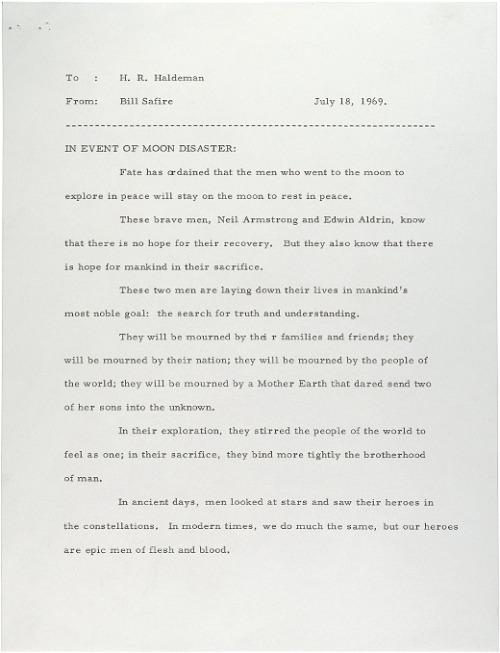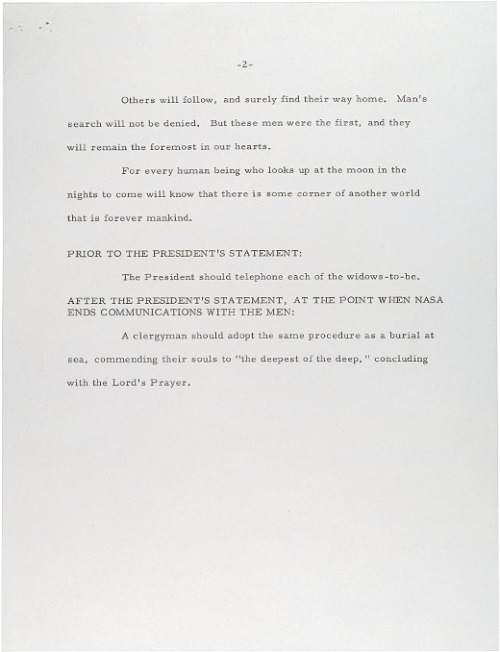40 YEARS AGO TODAY: The Surface Of Mars, As Seen By NASA’s Viking 2 Lander, September 25, 1977.

40 YEARS AGO TODAY: The surface of Mars, as seen by NASA’s Viking 2 lander, September 25, 1977.
More Posts from Needingsomespace and Others




Got to control the cameras (minus robotics) at NASA Johnson Space Center Mission Control for today’s SpaceX Dragon capture and was 536% fangirling the entire time. 😍🌟🌎🚀🎉

constellation Cetus
Sufi Latinus (Latin translation of ‘Kitāb al-kawākib al-thābita’ of 'Abd al-Rahmān al-Ṣūfī), Bologna 1250-1275
BnF, Arsenal 1036, fol. 34v

Il codice scritto in linguaggio assembly che portò l'America sulla Luna nel '69 è stato pubblicato su GitHub. La routine di accensione dei motori principali si chiama BURN_BABY_BURN Girano altre routine di gestione dell'allunaggio, dove pare ci siano stringhe di indicazioni per gli astronauti "GIRARE QUEL COSO SCEMO LÌ" "CONTROLLARE SE DICE CAZZATE"

Oggi 4 ottobre 2017, l'esplorazione spaziale celebra i suoi 60esimo anniversario con il lancio dello Sputnik1, il primo satellite artificiale. L'Unione Sovietica, nel 1957, non lanciò semplicemente un razzo ma una vera e propria sfida mondiale alla rivale U.S.A., dando inizio alla "Space Race", ovvero la corsa allo spazio. Quando ci viene raccontato dei primi lanci, non vengono mai citati i nove secoli di preparazione a questi eventi (sembra quasi che i Russi si siano svegliati un giorno e abbiano provato a lanciare qualcosa con successo!). Per capire quanto fosse enorme la necessità di andare oltre ogni confine, dobbiamo fare un salto indietro di qualche centinaio di anni! Possiamo ad esempio partire dall'XI secolo in Cina, dove una combinazione di zolfo, carbone e nitrato di potassio formano la polvere da sparo, il primo vero combustibile per i primi razzi bellici. Circa 500 anni dopo, in India, vengono migliorati i materiali di costruzione dei razzi, che saranno rivestiti di ferro, per una migliore stabilità. Nel marzo del 1926, Robert Goddard, considerato il pioniere della missilistica moderni, lancia il primo razzo alimentato con combustibile liquido, e tre anni dopo, nel luglio del 1929, lanciò un razzo attrezzato con i primi strumenti "scientifici", un barometro e una camera. Negli anni '40, verso la fine della seconda guerra mondiale, furono testati dalla Germania i primi missili balistici V-2, mentre l'America superò la barriera del suono con il Bell X-1. Queste sono solo due delle diverse sperimentazioni di successo di quegli anni, che portarono alla "corsa allo spazio" che raggiunse il suo apice con il successo dell'Apollo 11, che portò l'uomo sulla luna. Sessant'anni di trionfi, tragedie, investimenti e scoperte grazie ai quali, nel prossimo decennio, potremmo spingerci fisicamente su un altro pianeta!



An address to the nation to be read by President Richard Nixon should the Apollo 11 astronauts become stranded on the moon,
To: H. R. Haldeman From: Bill Safire July 18, 1969. ——————————————————————————- IN EVENT OF MOON DISASTER: Fate has ordained that the men who went to the moon to explore in peace will stay on the moon to rest in peace. These brave men, Neil Armstrong and Edwin Aldrin, know that there is no hope for their recovery. But they also know that there is hope for mankind in their sacrifice. These two men are laying down their lives in mankind’s most noble goal: the search for truth and understanding. They will be mourned by their families and friends; they will be mourned by the nation; they will be mourned by the people of the world; they will be mourned by a Mother Earth that dared send two of her sons into the unknown. In their exploration, they stirred the people of the world to feel as one; in their sacrifice, they bind more tightly the brotherhood of man. In ancient days, men looked at the stars and saw their heroes in the constellations. In modern times, we do much the same, but our heroes are epic men of flesh and blood. Others will follow, and surely find their way home. Man’s search will not be denied. But these men were the first, and they will remain the foremost in our hearts. For every human being who looks up at the moon in the nights to come will know that there is some corner of another world that is forever mankind. PRIOR TO THE PRESIDENT’S STATEMENT: The President should telephone each of the widows-to-be. AFTER THE PRESIDENT’S STATEMENT, AT THE POINT WHEN NASA ENDS COMMUNICATIONS WITH THE MEN: A clergyman should adopt the same procedure as a burial at sea, commending their souls to “the deepest of the deep,” concluding with the Lord’s Prayer.


TODAY IN HISTORY: On January 24, 1986, NASA’s Voyager 2 space probe made its closest approach to planet Uranus.

45 YEARS AGO TODAY: The Apollo 16 mission blasts off from Cape Canaveral on April 16, 1972.

The first photo of the surface of Mars, captured by NASA’s Viking 1 lander on July 20, 1976.

SDO Sees Solar Eclipse – “Image of the Moon transiting across the Sun, taken by SDO [Solar Dynamics Observatory] in 171 angstrom extreme ultraviolet light on August 21, 2017.” Photo credit: NASA/SDO [4096 x 4096]





February 24, 1969 – Apollo 11 moonwalkers Neil Armstrong and Buzz Aldrin train for the Moon by going on a geology field trip to the Sierra Blanca region in West Texas. (NASA)
-
 twobellsilence liked this · 5 years ago
twobellsilence liked this · 5 years ago -
 24kocylinder reblogged this · 5 years ago
24kocylinder reblogged this · 5 years ago -
 moonlightddrive liked this · 5 years ago
moonlightddrive liked this · 5 years ago -
 megatot liked this · 5 years ago
megatot liked this · 5 years ago -
 astrila reblogged this · 6 years ago
astrila reblogged this · 6 years ago -
 cantaloupecats-blog liked this · 6 years ago
cantaloupecats-blog liked this · 6 years ago -
 anonymousamethyst liked this · 6 years ago
anonymousamethyst liked this · 6 years ago -
 joanhello2 liked this · 6 years ago
joanhello2 liked this · 6 years ago -
 gardenercataloguer liked this · 6 years ago
gardenercataloguer liked this · 6 years ago -
 astrila liked this · 6 years ago
astrila liked this · 6 years ago -
 smokedcapybara liked this · 6 years ago
smokedcapybara liked this · 6 years ago -
 the-wyvernous liked this · 6 years ago
the-wyvernous liked this · 6 years ago -
 tverb liked this · 6 years ago
tverb liked this · 6 years ago -
 populusnix reblogged this · 6 years ago
populusnix reblogged this · 6 years ago -
 prepackagedsoul-blog liked this · 6 years ago
prepackagedsoul-blog liked this · 6 years ago -
 theworldtravellingteenager liked this · 6 years ago
theworldtravellingteenager liked this · 6 years ago -
 navigatorsnorth reblogged this · 6 years ago
navigatorsnorth reblogged this · 6 years ago -
 d-eadnam-e liked this · 6 years ago
d-eadnam-e liked this · 6 years ago -
 dearlybeloved-dreameater reblogged this · 6 years ago
dearlybeloved-dreameater reblogged this · 6 years ago -
 ass-lovr69 liked this · 7 years ago
ass-lovr69 liked this · 7 years ago -
 the-bandit-rose reblogged this · 7 years ago
the-bandit-rose reblogged this · 7 years ago -
 g-squares reblogged this · 7 years ago
g-squares reblogged this · 7 years ago -
 g-squares liked this · 7 years ago
g-squares liked this · 7 years ago -
 murderoftheuniverse liked this · 7 years ago
murderoftheuniverse liked this · 7 years ago -
 rabbithaver reblogged this · 7 years ago
rabbithaver reblogged this · 7 years ago -
 mancunienne reblogged this · 7 years ago
mancunienne reblogged this · 7 years ago -
 u-s-r liked this · 7 years ago
u-s-r liked this · 7 years ago -
 poezy reblogged this · 7 years ago
poezy reblogged this · 7 years ago -
 juve95-blog1 liked this · 7 years ago
juve95-blog1 liked this · 7 years ago -
 franknovsky-blog reblogged this · 7 years ago
franknovsky-blog reblogged this · 7 years ago -
 historychapters reblogged this · 7 years ago
historychapters reblogged this · 7 years ago -
 idliketoseeformyself liked this · 7 years ago
idliketoseeformyself liked this · 7 years ago -
 funtime315 liked this · 7 years ago
funtime315 liked this · 7 years ago -
 mustardtrash reblogged this · 7 years ago
mustardtrash reblogged this · 7 years ago -
 robdousy reblogged this · 7 years ago
robdousy reblogged this · 7 years ago -
 robdousy liked this · 7 years ago
robdousy liked this · 7 years ago -
 explaingravity liked this · 7 years ago
explaingravity liked this · 7 years ago -
 colombidae reblogged this · 7 years ago
colombidae reblogged this · 7 years ago -
 luxy-amigo liked this · 7 years ago
luxy-amigo liked this · 7 years ago